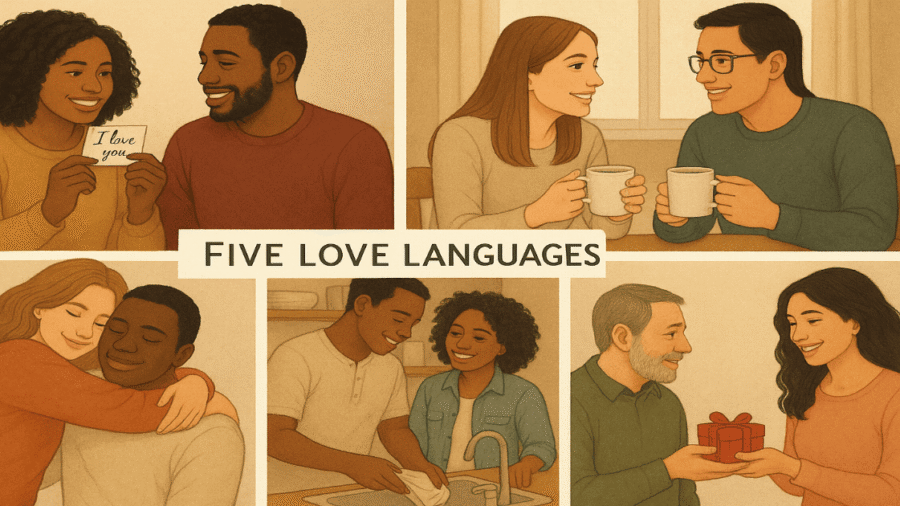There was a time when something as simple as holding hands or a heartfelt letter could melt your heart. But as days passed, you may have started to feel a disconnect, even if love was still present. Why? Because love, while universal, is not always spoken in the same dialect.
Understanding how we give and receive love can transform the way we connect emotionally. At the core of many relationship struggles lies one profound truth: we are not always speaking the same love language.
What Are Love Languages, and Why Do They Matter?
According to Dr. Gary Chapman there are five love languages, that represent various ways people express and experience love. For example, as one may want verbal affirmation, another may feel loved best by the time spent. Source
According to the Greater Good Science Center at UC Berkeley, even though empirical studies on love languages is still evolving, many therapists and couples use them as useful tool in communicating emotions to build intimacy in everyday life. Chapman’s model encourages self-awareness and reflection which are two key components of emotional intelligence.
The Five Love Languages
1. Words of Affirmation
This language is about spoken and written expressions of love. People who value this language feel most emotionally connected when they hear phrases like “I appreciate you,” “You are enough,” or “I love you just the way you are.”
This has nothing to do with flattery but everything to do with genuine acknowledgment. Compliments, gratitude, encouragement, and verbal affirmations all count. When couples use this language, they nurture their bond by affirming each other’s worth through words.
2. Acts of Service
To these individuals, actions speak louder than words. They feel most loved when others ease their burdens or show up in practical, helpful ways. This could be in the form of making dinner, handling chores without being asked, or helping with a project.
The message behind this love language is: “I care, and I want to lighten your load.“
3. Receiving Gifts
This is not materialism. For those who speak this language, a gift is a symbol of thoughtfulness and intention. The emotional connection comes from knowing someone thought of them and translated that emotion into a physical token either big or small.
4. Quality Time
This language centers on undivided attention. People who speak this love language feel bonded when others make a conscious effort to spend time with them without distraction.
It is not about proximity. It is about attentive presence: listening deeply, making eye contact, engaging in shared experiences, or having open conversations.
5. Physical Touch
For these individuals, physical presence and contact are vital for emotional connection. This can include hugs, hand-holding, back rubs, cuddling, or sexual intimacy.
It is less about the act and more about the emotional message: “I am here with you. You are safe.”
The Emotional Power of Feeling Understood
Love languages go beyond ordinary romantic gestures. They express an essential emotional need. Feeling understood, heard, and valued in the way human beings naturally connect. When your partner understands your love language and conveys it effectively, your emotional bond is strengthened.
Some studies revealed that couples who actively responded to the love language of their partners reported significantly higher relationship satisfaction. The key was not just knowing the love language, but expressing love in the way their partner most easily receives it. Source, Source
That is, love stops being feeling, love becomes translation.
Love Languages and Emotional Intelligence
Why do some people excel at showing love in just the right way, while others seem off-target despite having the best intentions? The answer may lie in emotional intelligence.
In the article How Emotional Intelligence Strengthens Romantic Relationships, the ability to empathise and regulate emotions is shown to be essential for healthy connection. These same emotional skills help partners learn and adapt to each other’s love languages.
Research from Personal Relationships suggests that individuals high in emotional intelligence can control their behaviours to match their partner’s needs to increase relational satisfaction. The ability to “walk the walk” and “talk the talk” is what separates good relationships from great ones.
Miscommunication: When Love Gets Lost in Translation
Even in healthy relationships, misfires happen. You may think you are expressing love clearly, but your partner may still feel neglected.
This emotional disconnection is especially common when love languages clash. For example, the case in which you express love by doing things for someone (Acts of Service), but your partner feels most loved through verbal appreciation (Words of Affirmation), resentment may quietly build.
The post How to Handle Relationship Anxiety discusses how unmet emotional needs often manifest as worry or insecurity. By identifying and matching love languages such anxiety can be calmed by establishing emotional safety.
How to Identify and Adapt to Each Other’s Love Languages
Here are steps you can take to build a deeper emotional connection using love languages:
1. Learn Your Own Love Language
- Reflect on how you naturally show affection.
- Consider moments when you felt most loved and what made those moments stand out?
2. Ask Open-Ended Questions
- “When do you feel most appreciated?”
- “What is something I did recently that made you feel truly seen?”
3. Practice Active Listening
- Listen without defensiveness when your partner expresses their needs.
- Validate their perspective, even if it differs from yours.
4. Make Love a Daily Habit
- Speak your partner’s love language intentionally, even in small, consistent ways.
- Rotate your gestures to explore new expressions of love.
5. Revisit and Recalibrate
- People grow and change so do their emotional needs.
- Schedule monthly “emotional check-ins” to realign.
When Love Languages Help You Choose the Right Partner
Love languages also play a role in the attraction phase. In the post The Psychology of Attraction: What Really Draws Us to Others, emotional compatibility is the key thing to know. Some people are naturally drawn to those who express affection in similar ways, while others may find opposites exciting yet confusing.
Shared love languages are not essential, but shared willingness to learn each other’s language is. This creates what researchers call “emotional reciprocity”, the lifeblood of healthy attachment.
Experience a Love That Feels Like Home
Love languages are not a magic fix. But they are mirrors, reflecting back to us how we want to be loved how we can better cherish others.
According to the Greater Good Science Center, even if the scientific debate around love languages continues, their emotional logic still holds weight. The simple act of learning how someone wants to be loved and showing up in that way can rebuild trust, connection, and joy.
Because at the end of the day, love is not just about feeling. It is about understanding.



Add a Comment